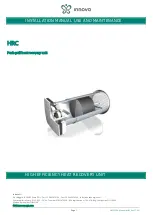
2 Mounting
Select a location likely to intercept an intruder moving beneath and across
the coverage pattern. Refer to
Figure 2.1
. Recommended mounting height
range is 8 to 18 feet (2.4 to 5.5 m).
The surface should be solid and vibration-free. (i.e. Drop tiles should
be secured if the area above the tiles is used as an air return for HVAC
systems).
Figure 2.1: Coverage Pattern
1. Remove the base from the enclosure by pressing the two enclosure
release tabs inward while lifting the enclosure away from the base.
Refer to
Figure 2.2
.
9 m
8 m
6 m
4 m
2 m
0 m
2 m
4 m
6 m
8 m
9 m
30 ft
26 ft
20 ft
13 ft
7 ft
0 ft
7 ft
13 ft
20 ft
26 ft
30 ft
30 ft
26 ft
20 ft
13 ft
7 ft
0 ft
7 ft
13 ft
20 ft
26 ft
30 ft
≤5.5 m
≥4.0 m
4.6 m
0 m
≤4.0 m
3.0 m
≥2.4 m
0 m
9 m
8 m
6 m
4 m
2 m
0 m
2 m
4 m
6 m
8 m
9 m
0 ft
≥8 ft
10 ft
≤13 ft
0 ft
≥13 ft
15 ft
≤18 ft
AR13-18
AR8-13
Optical module
Interface connector
Cover twist tabs (4)
Test lead
cutout
Enclosure release openings (2)
Anti-vandal
locking screw
holes (2)
Interface
pins
Enclosure release tabs
Figure 2.2: Opening cover
NOTICE!
Slightly rock the enclosure side-to-side during removal to overcome the
friction caused by the base-to-enclosure terminal pins.
2. Open the cover by turning counterclockwise.
3. Route wiring as necessary to the rear of the base and through the
center hole. Refer to
Figure 2.3
.
6.2 False Alarm Prevention
Turn on all heating and cooling sources that would normally be in
operation during times of protection. Stand away from the unit and
outside the coverage pattern, then monitor the background noise for at
least three minutes.
Readings should not deviate from the reference level more than ±0.15
VDC. For readings outside these limits; eliminate the cause, rotate the unit
slightly, or mask out the mirror segment(s) looking down at the thermal
disturbance.
6.3 Coverage Margin
Again walk across the farthest edge of required coverage.
A minimum voltage change of 1.0 VDC from the reference level is required
in the wintertime when the background temperature is cool. This will make
up for summertime, when the background is warmer. If testing the unit in
the summertime, the minimum recommended voltage change is 0.75 VDC.
When testing is completed, remove the TC6000 Test Cord, and twist-lock
the cover into place.
6.4 Supervision Feature
The DS938Z performs several supervision features that, combined with
the advanced motion detection capabilities of the detector, provide
an extremely high level of security. A supervision trouble condition is
indicated at the detector by the Alarm/Test LED (see the Supervision
Display Chart).
• The LED indicates the cause of the supervision trouble using coded
pulses. The supervision trouble signal activates the Trouble Output
available at terminal 8, which should be connected to a 24-hour zone.
The supervision features function as follows:
LED
CAUSE
ON
Unit alarm
2 Flashes
Motion monitor time out
4 Flashes
PIR self-test failure
PIR:
The operation of the PIR is electronically checked approximately
every 12 hours. If the PIR fails, the Alarm/Test LED will fl ash four times and
the Trouble Output will activate.
Motion Monitor Supervision:
This feature verifi es that the detector has a
clear view of the detection area and has not been blocked. When selected
using switches S4 and S5, a supervision timer is activated. A trouble
condition will be indicated if the detector has not alarmed at least once
during the selected time period (this feature can be disabled by placing
both switches in the Off position). The time period selected should be
long enough to allow adequate time for holiday weekends.
Refer to
Section 4.0 Feature Selection
for proper switch settings.
4 © 2013 Bosch Security Systems, Inc.
F.01U.263.663 | 04 | 2013.04 |
9
Available from A1 Security Cameras
www.a1securitycameras.com email: [email protected]
























